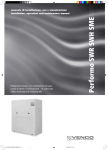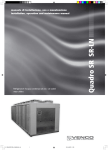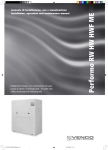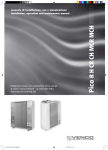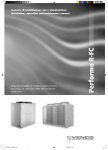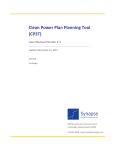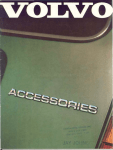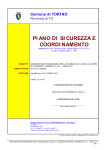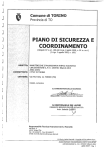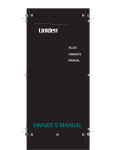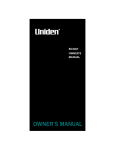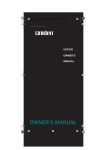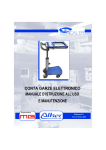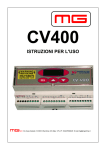Download Manuale_Performo_SR_italiano
Transcript
manuale di installazione, uso e manutenzione Performo SR SR-LN installation, operation and maintenance manual Refrigeratori d’acqua condensati ad aria - air cooled water chillers IC_PERF SR SR-LN_MANUAL_A4 1 31-05-2007, 11:06 MANUALE TECNICO norme di sicurezza installazione uso e manutenzione AVVERTENZE GENERALI Il presente manuale fa parte, assieme allo schema elettrico, al manuale del microprocessore e agli allegati specifici per modello, della documentazione fornita a corredo della macchina. Il tutto deve essere conservato con cura e messo a disposizione dell'operatore per ogni ulteriore consultazione. Tutti gli interventi di manutenzione ordinaria e straordinaria devono essere eseguiti, nel rispetto delle norme di sicurezza, da personale abilitato. ser ie : P ERFO RMO S R - SR LN cod. : MTPE00 rev. : I-06-07 SOMMARIO SICUREZZA pag. 3 RICEVIMENTO E IMMAGAZZINAGGIO pag. 4 MOVIMENTAZIONE pag. 4 POSIZIONAMENTO pag. 5 INSTALLAZIONE : collegamenti idraulici pag. 5 INSTALLAZIONE : collegamenti elettrici pag. 6 PRIMO AVVIAMENTO - FUNZIONAMENTO pag. 6 SOSTA INVERNALE pag. 8 MANUTENZIONE : ordinaria e straordinaria pag. 8 SMANTELLAMENTO UNITA' pag. 8 SCHEMA FRIGORIFERO pag. 9 CIRCUITO IDRAULICO pag. 10 SISTEMA DI CONTROLLO pag. 11 ALLARMI pag. 13 2 SI CUREZZA La macchina è stata progettata in modo da ridurre al minimo i rischi per la sicurezza delle persone che con essa andranno ad interagire. In sede di progetto non é stato tecnicamente possibile eliminare completamente le cause di rischio. Pertanto è assolutamente necessario fare riferimento alle prescrizioni di seguito riportate. Accesso all'unità L'accesso all'unità una volta che è stata installata, deve essere consentito solamente a operatori e tecnici abilitati. Per operatore si intende una persona autorizzata dal proprietario della macchina a compiere operazioni sulla stessa (in accordo con quanto riportato nel presente manuale). Per tecnico si intende una persona autorizzata dalla VENCO o in subordine sotto la sua completa responsabilità da un distributore VENCO, a compiere operazioni sulla macchina. Per proprietario della macchina si intende il legale rappresentante della società, ente o persona fisica proprietaria dell'impianto in cui è installata la macchina VENCO. Egli é responsabile del rispetto di tutte le norme di sicurezza indicate dal presente manuale e dalla normativa vigente. Qualora per la natura del luogo di installazione non possa essere impedito l'accesso alla macchina da parte di estranei, deve essere prevista una zona recintata attorno alla macchina ad almeno 1,5 metri di distanza dalle superfici esterne, all'interno della quale possono operare solo operatori e tecnici. Gli operatori o tecnici devono operare sulla macchina con un opportuno abbigliamento antinfortunistico (scarpe, guanti, elmetti ecc.) e con opportuni utensili. Rischi residui L'installazione, l'avviamento, lo spegnimento, la manutenzione della macchina devono essere tassativamente eseguiti in accordo con quanto riportato nella documentazione tecnica del prodotto e comunque in modo che non venga generata alcuna situazione di rischio. I rischi che non é stato possibile eliminare in fase di progettazione sono riportati nella tabella seguente. parte considerata rischio residuo modalità batteria di scambio termico piccole ferite da taglio contatto griglia ventilatore e ventilatore lesioni interno unità : compressore e tubo di mandata interno unità : parti metalliche e cavi elettrici esterno unità : zona circostante unità ustioni intossicazioni, folgorazione, ustioni gravi intossicazioni, ustioni gravi inserimento di oggetti appuntiti attraverso la griglia mentre il ventilatore sta funzionando contatto precauzioni evitare il contatto, usare guanti protettivi non infilare oggetti di alcun tipo dentro la griglia dei ventilatori e non appoggiare oggetti sopra le griglie evitare il contatto, usare guanti protettivi difetto di isolamento cavi alimentazione a monte del quadro elettrico dell'unità; parti metalliche in tensione protezione eletttrica adeguata della linea alimentazione; massima cura nel fare il collegamento a terra delle parti metalliche incendio a causa corto circuito o surriscaldamento della linea alimentazione a monte del quadro elettr.dell'unità sezione dei cavi e sistema di protezione della linea alimentazione elettrica conformi alle norme vigenti 3 RI CEVI MENTO E I MMAGAZZI NAGGI O Controllare, all'atto del ricevimento, che il materiale non abbia subito danni e che corrisponda a quanto indicato nel documento di accompagnamento. Eventuali danni, o situazioni di consegna incompleta devono essere tempestivamente segnalati. Il gruppo potrà essere immagazzinato in locali protetti dagli agenti atmosferici con temperature da -20°C a massimo +55°C. MOVI MENTAZI ONE Le unità possono essere movimentate sia con carrelli elevatori che con gru. Bisogna prestare particolare attenzione a non danneggiare, durante la movimentazione, la batteria di condensazione. Fare riferimento ai pesi riportati negli allegati. Si consiglia la movimentazione della macchina imballata. Sollevamento con carrello elevatore Se si usa un carrello elevatore, assicurarsi prima di ogni cosa che sia di portata adeguata e che le forche siano lunghe almeno 1300 mm. L'unità deve essere sollevata posizionando le forche del carrello secondo le indicazioni riportate nella figura seguente. Assicurarsi che l'unità sia in perfetto equilibrio stabile. 1000 Le forche del carrello devono sporgere di almeno 50 mm. Sollevamento con gru Deve essere effettuato secondo lo schema in basso seguendo le istruzioni riportate. Usare un bilancino o delle barre divaricatrici, corde di adeguata portata (non catene), tubi di diametro 42 mm (1" 1/4) che dovranno essere infilati nei fori predisposti nel basamento della macchina; bloccare le estremità dei tubi con spine e copiglie evitando che le corde si sfilino. Assicurarsi che l'unità sia in perfetto equilibrio stabile. A spina spina B tubo ø60 mm 4 POSI ZI ONAMENTO Spazio di rispetto per il funzionamento e la manutenzione L' unità deve essere installata rispettando gli spazi tecnici riportati negli allegati. Il piano su cui poggia l'unità deve essere livellato e robusto adatto a sopportarne il peso durante il funzionamento. Antivibranti Al fine di evitare trasmissione di vibrazioni alla struttura portante è opportuno installare negli appositi fori ricavati nel basamento dell'unità dei supporti antivibranti (in gomma, forniti come accessorio opzionale). Il montaggio degli antivibranti è evidenziato nello schema riportato negli allegati. I NSTALLAZI ONE Collegamenti idraulici Si consiglia di effettuare il collegamento idrico del refrigeratore in accordo con lo schema seguente. In particolare è assolutamente necessario installare sulla tubazione di ingresso un filtro contro le eventuali impurità contenute nell'acqua. La mancata installazione di detto filtro comporta il decadimento della garanzia Le tubazioni devono essere adeguatamente installate e sostenute cosicchè esse non vadano a caricare gli attacchi sull'unità. Il kit idrico incorporato é formato da: pompa di circolazione, valvole sfiato aria, pressostato differenziale. Se l'unità è senza kit idrico è necessario installare una pompa, un serbatoio accumulo coimbentato, un vaso espansione. VS RC M F VS P SE T GA FA VI VI SA Refrigeratore M VS INGRESSO ACQUA T GA VI USCITA ACQUA DISPOSITIVI DA INSTALLARE A CURA DELL'INSTALLATORE. RS RC M T FA Refrigeratore con kit idrico incorporato M F VS GA VS VI INGRESSO ACQUA T GA VI USCITA ACQUA DISPOSITIVI DA INSTALLARE A CURA DELL'INSTALLATORE. RS M = manometro RC = rubinetto di scarico RS = rubinetto di scarico VS = sfiato aria FA = filtro acqua GA = giunto antivibrante T = termometro VI = valvola intercettazione F = flussostato esterno P = pompa SE = vaso espansione SA = serbatoio accumulo 5 Collegamenti elettrici Nei disegni dimensionali riportati negli allegati è indicata la posizione prevista per l'ingresso dei cavi di alimentazione. Per accedere al quadro elettrico e quindi alla morsettiera di alimentazione é necessario smontare il pannello alto frontale. Per il dimensionamento della linea di alimentazione fare riferimento ai valori di potenza e corrente riportati nella tabella degli allegati. Lo schema elettrico della macchina si trova all'interno del vano compressore assieme al resto della documentazione a corredo. E' necessario porre particolare attenzione ai seguenti punti: - i collegamenti elettrici devono essere eseguiti da personale qualificato; - i cavi di alimentazione devono essere protetti a monte contro gli effetti del cortocircuito e del sovraccarico da un dispositivo idoneo conforme alle leggi vigenti; - la sezione dei cavi deve essere commisurata alla taratura del sistema di protezione a monte e deve tenere conto di tutti i fattori che la possono influenzare (temperatura, tipo di isolante, lunghezza, ecc.); - è molto importante che il collegamento alla rete di terra sia effettuato con la massima cura. - verificare il tipo di alimentazione che puo' essere trifase o trifase con neutro. Nella morsettiera del quadro elettrico sono previsti due coppie di morsetti (contatti puliti): una é per l'allarme generale a distanza, l'altra é per l'ON OFF remoto (vedi schema elettrico). PRI MO AVVI AMENTO O AVVI AMENTO DOPO UNA LUNGA SOSTA - FUNZI ONAMENTO Prima di procedere all'avviamento del refrigeratore é necessario effettuare controlli preliminari della parte elettrica, idraulica e frigorifera. Almeno 12 ore prima di avviare l'unità deve essere accesa la resistenza elettrica del compressore per far evaporare tutto il refrigerante presente nell'olio. Cont r ol l i pr el i mi nar i - par t e el et t r i ca Prima di effettuare i controlli di cui al presente paragrafo è necessario assicurarsi che la linea di alimentazione elettrica dell'unità sia sezionata a monte della stessa. Assicurarsi che il dispositivo di sezionamento sia lucchettato o che sulla maniglia di azionamento sia applicato l'apposito cartello di avvertimento a non operare. Ogni intervento va eseguito in mancanza di tensione procedendo come di seguito: - togliere pannello frontale superiore; - portare l'interruttore generale nella posizione "0" (OFF); - aprire lo sportello del quadro elettrico; - verificare che i cavi di alimentazione siano opportunamente dimensionati; - verificare che il refrigeratore sia connesso all'impianto di terra; - verificare il corretto serraggio delle viti che fissano i conduttori ai componenti elettrici presenti nel quadro in modo da garantire unadeguato contatto; - chiudere lo sportello del quadro elettrico. A questo punto si può dare tensione alla macchina chiudendo il dispositivo di sezionamento della linea e portando l'interruttore generale della macchina nella posizione "1" (ON). Controllare, con un voltmetro, i valori della tensione di fase fornti all'unità. Il valore della tensione di alimentazione deve essere 400 V +/- 10 %. Determinare la tensione media di fase (RS+ST+RT)/3 e la differenza percentuale fra ciascuna delle tensioni di fase e questo valore medio. La differenza massima non deve essere superiore al 3 %. Una variazione maggiore annulla la garanzia. ESEMPIO: R-S= 397V ; S-T= 406V ; R-T= 395V media dei valori : (397+406+395) / 3 = 399,3 differenza percentuale : (406-397) / 399,3 x 100 = 2,25 % (406-395) / 399,3 x 100 = 2,75 (397-395) / 399,3 x 100 = 0,5 % 6 Cont r ol l i pr el i mi nar i - par t e i dr aul i ca - Controllare il corretto collegamento fra gli attacchi idrici della macchina e le tubazioni dell'impianto; - controllare che le valvole di intercettazione del circuito idraulico siano aperte; - controllare che l'impianto sia carico; sfiatare tutta l'aria dall'impianto; - controllare, durante il funzionamento, che la pompa di circolazione sia funzionante e che il senso di rotazione della stessa sia in senso orario (vista difronte alla calotta copriventola); - controllare che la portata d'acqua corrisponda a quella di progetto, assicurarsi che sia garantita sempre una portata d'acqua costante. Cont r ol l i pr el i mi nar i - par t e f r i gor i f er a Controllare visivamente l'integrità dei vari componenti del circuito frigorifero. Sui compressori assicurarsi che il livello dell'olio lubrificante sia a circa metà dell'apposito spioncino. Av v i ament o Dopo aver eseguito i controlli preliminari dell'unità, premere il tasto "ON/OFF" sul terminale del microprocessore. Il led "ON/OFF" diventerà verde e l'unità si avvierà. NOTA IMPORTANTE : nell'unità è installato il compressore bivite. E' molto importante controllare il senso di rotazione del compressore. Se alimentato con la sequenza fasi sbagliata gira in senso contrario. In tal caso è molto rumoroso e rischia di danneggiarsi: invertire immediatamente le fasi. Per un controllo piu' preciso del senso di rotazione, collegare attraverso le apposite prese di pressione un gruppo manometri e verificare che le pressioni siano esatte. Funzi onament o a r egi me Il sistema di controllo a microprocessore del refrigeratore regolerà la potenza frigorifera della macchina (accensione, spegnimento del compressore) in dipendenza del carico termico dell'impianto; controllare le temperature di ingresso e uscita acqua: la differenza tra tali temperature non deve superare il limite massimo di circa 7°C. Una differenza di temperatura maggiore è sintomo di scarsa portata d'acqua (rispetto al valore nominale) o presenza di aria nell'impianto. Spegni ment o e accensi one Per spegnere temporaneamente l'unità premere il tasto "ON/OFF" della tastiera microprocessore. Per lunghi periodi di fermata sezionare la macchina agendo sull'interruttore generale del quadro elettrico. 7 SOSTA I NVERNALE Se l'impianto idraulico è stato caricato con acqua è necessario provvedere alla sua evacuazione a fine stagione estiva per evitare la formazione di ghiaccio durante l'inverno. Se l'impianto è stato caricato con soluzione antigelo l'operazione non deve essere effettuata. Prima dell'inizio della stagione fredda è necessario verificare con un densimetro la concentrazione di glicole della miscela, rabboccando il circuito se necessario. MANUTENZI ONE Manut enzi one or di nar i a La manutenzione ordinaria consiste in semplici operazioni che si consiglia di eseguire con cadenza mensile procedendo come segue: - verificare che il cavo elettrico di alimentazione della macchina non presenti alterazioni che ne compromettano l'isolamento; - verificare il corretto serraggio delle viti che fissano i conduttori ai componenti elettrici presenti nel quadro elettrico in modo da garantire un corretto collegamento elettrico; lo stesso dicasi per i collegamenti di messa a terra. - controllare che non ci siano perdite nel circuito idraulico; - controllare, durante il funzionamento del compressore le pressioni di mandata e aspirazione. E' necessario rimuovere il pannello del vano compressore e collegarsi con i manometri sulle opportune prese di pressione predisposte nel circuito frigorifero. Questa operazione deve necessariamente essere effettuata da personale abilitato. Manut enzi one st r aor di nar i a La manutenzione straordinaria consiste in operazioni che si rendono necessarie a seguito di anomalie di funzionamento. Rientrano in questi casi: lo scarico del refrigerante, la carica di refrigerante, il rabbocco d'olio, la sostituzione del filtro deidratore, la messa in vuoto dei circuiti, configurazione del controllo. Queste operazioni devono essere eseguite tassativamente da personale abilitato. SMANTELLAMENTO DELL’ UNI TA’ La macchina è stata progettata e costruita per garantire un funzionamento continuativo. La durata di alcuni componenti principali, ad esempio il compressore, dipende dalla manutenzione a cui è stato sottoposto. In caso di smantellamento dell'unità, l'operazione dovrà essere eseguita da personale frigorista specializzato. Il fluido frigorigeno e l'olio lubrificante contenuti nel circuito dovranno essere recuperati, in accordo con le norme vigenti nel Vostro Paese. 8 SCHEMA FRI GORI FERO CN F VC IL VC VL C PA RC M ~ Tp St VC VC EV EVE Tp Drv Tp LEGENDA C compressore PA pressostato di alta press. EVE valvola di espansione elettronica VC attacchi gas di servizio CN condensatore EV evaporatore PD pressostato differ. (lato acqua) VL ventilatori F filtro deidratore Drv St PD VC VSLP IL RC Tp St Drv Tp Drv St valvola di sicurezza di bassa pressione indicatore di liquido resistenza carter trasduttore di pressione sonda di temperatura trasduttore di pressione del driver sonda di temperature del driver RL r ubi net t o l i qui do VSHP valvola di sicurezza di alta pressione 9 CIRCUITO IDRAULICO ingresso acqua PD VA P VS uscita acqua FA EV SE LEGENDA FA VA VS PD filtro acqua (a cura del cliente) valvola di sicurezza (3 bar) valvola sfiato aria p r es sostato differenziale 10 SE P EV vaso di espansione pompa ev apo r ato re SISTEMA DI CONTROLLO Il terminale utente previsto è con LCD (4 righe per 20 colonne) e di tipo esterno collegato alla scheda a microprocessore attraverso un cavo telefonico. Permette di visualizzare le condizioni di funzionamento dell'unità in ogni momento, modificare i parametri, gestire gli allarmi attraverso la segnalazione visiva (display) e sonora Terminal menu I/O ? info on/off set alarm prog. enter Pulsanti di utilizzo MENU Visualizza i valori rilevati dalle sonde. ASSISTENZA Visualizza i valori relativi alla manutenzione dei dispositivi (ore di utilizzo del dispositivo e reset contaore di funzionamento). STAMPANTE Accede al gruppo di maschere per la gestione della stampante (ove prevista) I/O Visualizza lo stato degli ingressi e delle uscite, sia digitali che analogiche. OROLOGIO Permette la visualizzazione/programmazione dell'orologio (se presente). SETPOINT Consente l'impostazione del set point. PROGRAM Consente l'impostazione dei vari parametri di funzionamento (protezioni, soglie, etc…). MENU+PROG Premendo contemporaneamente questi tasti si entra nella configurazione della macchina (numero di dispositivi collegati al pCO1, programmazione dei fondo scala e calibrazione sonde, etc…). INFO Visualizza la versione del programma applicativo ed altre informazioni. I led a fianco di ciascun tasto si illuminano quando la relativa funzione è attivata. 11 Tasti esterni ON/OFF Consente l'accensione e lo spegnimento della macchina. Il LED verde che illumina il tasto indica se l'accensione è stata effettuata. ALARM E' utilizzato per la visualizzazione su display degli allarmi, per il loro rirpistino manuale e per la tacitazione del cicalino. Se il tasto è illuminato (colore rosso) significa che è stato rilevato almeno un allarme. FRECCIA SU Per la gestione delle maschere su display e per l'impostazione dei valori dei parametri di controllo (non retroilluminato). FRECCIA GIU' Per la gestione delle maschere su display e per l'impostazione dei valori dei parametri di controllo (non retroilluminato). ENTER 12 Per la conferma dei dati impostati. Il tasto è costantemente retroilluminato (luce gialla) per indicare la presenza dell'alimentazione. ALLARMI Gli allarmi sono divisi in tre categorie: Allarmi di sola segnalazione: sola segnalazione a display e buzzer, segnalazione su display, buzzer, relè di allarme. Allarmi di circuito: disattivano solo il circuito relativo, segnalazione su display, buzzer, relè di allarme. Allarmi gravi: disattivano l'intero sistema, segnalazione su display, buzzer, relè di allarme. Allarmi gravi - Allarme mancanza flusso acqua - Allarme antigelo evaporatore a riarmo manuale - Allarme grave da ingresso digitale - Allarme monitore di fase - Termico pompa Allarmi di circuito - Allarme alta pressione/pressostato - Allarme bassa pressione - Allarme termico compressore - Allarme differenziale olio - Allarme termico ventilatore - Allarme unità sconnesse dalla rete - Allarme differenziale pressioni Allarmi di sola segnalazione - Allarme manutenzione unità - Allarme manutenzione compressori - Allarme schedina orologio guasta o sconnessa Gestione allarme differenziale pressioni Ingressi utilizzati - Trasduttore di bassa pressione - Trasduttore di alta pressione Parametri utilizzati - Abilitazione allarme - Set point differenziale pressioni - Ritardo attivazione allarme Uscite utilizzate - Relè di allarme generale - Tutte le uscite relative ai compressori Descrizione funzionamento L'allarme si basa sul differenziale tra le letture delle sonde di alta e bassa pressione. Se questo scende al di sotto del valore di differenziale impostato, viene segnalato l'allarme e spento il compressore, secondo il ritardo impostato. 13 Tabella allarmi pCO Codice Descrizione Allarme OFF Compressori Allarme Grave * Allarme Monitore di Fase * Termico Pompa Evaporatore * Termico Pompa Condensatore * Flussostato Evaporatore * Flussostato Condensatore * Allarme Antigelo * Unità 1 Offline * Unità 2 Offline * Unità 3 Offline * Unità 4 Offline * Termico Compressore * Pressostato Differenziale Olio * Basso Differenziale Pressioni * Pressostato Bassa Pressione * Pressostato Alta Pressione * Bassa Pressione Trasduttore * Alta Pressione Trasduttore * Termico Ventilatore 1 Termico Ventilatore 2 Alta Tensione Alta Corrente Manutenzione Pompa Evap. Manutenzione Pompa Cond. Manutenzione Compressore Sonda Guasta B1 * Sonda Guasta B2 * Sonda Guasta B3 Sonda Guasta B4 Sonda Guasta B5 Sonda Guasta B6 Sonda Guasta B7 Sonda Guasta B8 Scheda Orologio 32KB Guasta 011 012 018 019 013 014 031 001 002 003 004 020 015 032 017 016 034 033 021 022 036 037 051 052 053 060 061 062 063 064 065 066 067 041 OFF Ventilatori * * * * * * * * * * * OFF Pompa * * * * * * * * * * OFF Sistema * * * * * * * * * * * * * * * * * * * * * * * Riarmo Manuale Manuale Manuale Manuale Manuale Manuale Manuale Automatico Automatico Automatico Automatico Manuale Manuale Manuale Manuale Manuale Manuale Manuale Manuale Manuale Manuale Manuale Manuale Manuale Manuale Automatico Automatico Automatico Automatico Automatico Automatico Automatico Automatico Manuale Ritardo Impostabile Impostabile 50 / 30 s 50 / 30 s 50 / 30 s 50 / 30 s Impostabile Impostabile Impostabile 10 s 10 s 10 s 10 s 10 s 10 s 10 s 10 s Segnalazione Mst/Slv Mst/Slv Mst Mst Mst/Slv Mst/Slv Mst/Slv Slv Mst Mst Mst Mst/Slv Mst/Slv Mst/Slv Mst/Slv Mst/Slv Mst/Slv Mst/Slv Mst/Slv Mst/Slv Mst/Slv Mst/Slv Mst Mst Mst/Slv Mst Mst/Slv Mst/Slv Mst/Slv Mst/Slv Mst/Slv Mst/Slv Mst/Slv Mst/Slv Allarmi delle schede Driver Codice 101 102 103 104 105 106 107 108 109 110 111 201 202 203 204 205 206 207 208 209 210 211 14 Descrizione Allarme OFF Compressori Errore sonda driver 1 * Errore eeprom driver 1 * Errore stepper motore driver 1 * Errore batteria driver 1 * Alta pressione sul driver 1 Bassa pressione sul driver 1 Basso super-heat driver 1 * Valvola non chiusa durante * spegnimento driver 1 Alta temperatura di aspirazione driver 1 Attesa per errore * eeprom/ricarica batteria o valvola aperta driver 1 Lan sconnessa driver 1 * Errore sonda driver 2 * Errore eeprom motor driver 2 * Errore stepper motore driver 2 * Errore batteria driver 2 * Alta pressione sul driver 2 Bassa pressione sul driver 2 Basso super-heat driver 2 * Valvola non chiusa durante * spegnimento driver 2 Alta temperatura di aspirazione driver 2 Attesa per errore * eeprom/ricarica batteria o valvola aperta driver 2 Lan sconnessa driver 2 * OFF Ventilatori OFF Pompa OFF Sistema Riarmo Ritardo Segnalazione Manuale Manuale Manuale Manuale Manuale Manuale Manuale Manuale Mst Mst/Slv Mst/Slv Mst/Slv Mst/Slv Mst/Slv Mst/Slv Mst/Slv Manuale Mst/Slv Manuale Mst/Slv Manuale Manuale Manuale Manuale Manuale Manuale Manuale Manuale Manuale o Mst/Slv Mst/Slv Mst/Slv Mst/Slv Mst/Slv Mst/Slv Mst/Slv Mst/Slv Mst/Slv Manuale Mst/Slv Manuale Mst/Slv Manuale Mst/Slv TECHNICAL MANUAL safety standars installation use and maintenance GENERAL INSTRUCTIONS Together with the wiring diagram, the microprocessor manual and the specific enclosures for the model, this manual is a part of the documentation supplied with the machine. This must be kept carefully and be available to the operator for future reference. All ordinary and extraordinary maintenance must be carried out by authorised personnel in compliance with the safety regulations. s er ies : PERF ORM O SR - SR L N cod. : MTPE00 rev. : E -06-07 INDEX SAFETY page 3 RECEPTION AND STORAGE page 4 MOVEMENT page 4 POSITIONING page 5 INSTALLATION: hydraulic connections page 5 INSTALLATION: electrical connections page 6 INITIAL START-UP - OPERATION page 6 WINTER STORAGE page 8 MAINTENANCE: ordinary and extraordinary page 8 DISPOSING OF THE UNIT page 8 REFRIGERATION DIAGRAM page 9 WATER KIT DIAGRAM page 10 ELECTRONIC CONTROL SYSTEM page 11 ALARMS page 13 2 SA F E T Y The machine has been designed to minimize hazards for the safety of persons dealing with it. When planning the machine it was not technically possible to eliminate all risks entirely. Therefore, it is absolutely essential to follow the instructions set down below. Access to the unit Once the unit has been installed, only authorised operators and technicians must be allowed access to it. By operator we intend a person authorised by the owner of the machine to carry out operations using this machine (in compliance with the instructions set down in this manual). By technician we intend a person authorised by VENCO, or a subordinate under the direct responsibility of a VENCO distributor, to carry out operations on the machine. By owner of the machine we intend the legal rapresentative of the company, body or individual owning the system in which the VENCO machine has been fitted. This person is responsible for compliance with all the safety regulations set down in this manual and in the laws in force. Should it be impossible, owing to the place in which the machine is installed, to prevent strangers from gaining access to the machine, a fenced-in area must be provided around the machine at to less than 1,5 metres from the outer surface, within which only operators and technicians may gain access. When working on the machine, operators or technicians must wear protective clothing (footwear, gloves, helmets, etc.) and use suitable tools. Remaining risks Installation, start-up, shut-down and maintenance on the machine must be carried out in strict compliance with the techincal documentation of the product and in any case, in such as way as no hazardous situations are created. Hazards that were impossible to eleminate during planning are set down in the table below. part remaining risk method precautions heat exchange battery small cuts contact avoid contact, use protective gloves fan grille and fan lesions inside the unit : compressor and delivery pipe burns inside the unit : metal parts and electric wires intoxication, shock, serios burns outside the unit : areas around the unit intoxication, serios burns introducing sharp ob- do not introduce objects of any jects through the grille type through the ventilator grilwhile the fan is opera- les and do not lay anything on ting the grilles contact avoid contact, use protective gloves faults in power cable insulation upstream of the unit switchboard; live metal parts appropriate electrical protection of the power line, extreme care over earth connections of metal parts fires caused by short-circuit or overheating of the power line upstream of the unit switchboard cable section and protective system of the power line in compliance with the standars in force 3 R E C E P T I O N A N D S T O R AG E Check upon delivery that the goods have not been demaged and that they correspond to the information in the waybill. Any damage or incomplete deliveries must be quickly communicated. The unit may be stored in a place protected from weather conditions with temperature ranging from -20°C to +55°C maximum. M OV E M E N T Units can either be moved by lift trucks or cranes. Particular care must be taken not to damage the condesation battery during movement. Refer to the weights set down in the enclosures. It is advisable to move the machine while still packed. Lifting with lift truck If using a lift truck, firstly check that the capacity is appropriate and the forks are at least 50 mm in lenght. The unit must be lifted with the forks of the truck positioned according to the indications shown in the figure below. Make sure that the unit is perfectly balanced 1000 LLe ift fforc orkshe mdel ust carr stickello out dev ab ouono t 50spo mmrgere di almeno 50 mm. Lifting with a crane This must be carried out according to the diagram below and folling the instructions: Use: a balance or forked bars; suitably sturdy rope (not chains), pipes with a diameter of 42 mm (1"1/4) which must be threaded into the holes in the base of the machine; block the pipe ends with pins and split pins, to prevent the ropes from slipping Make sure that the unit is perfectly balanced A pinna spi spi pina n B ttub ubeodø60 . 60mm mm 4 P O S I T I ON I N G Spaces to comply with for operation and maintenance The unit must be installed in compliance with the technical distances indicated in the enclosures. The surface on which the unit rests must be level and sufficently sturdy to withstand the weight during operation. Vibration dampers In order to prevent vibration from being transmitted to the load-bearing structure it is advisable to fit vibration damping supports (in rubber or springs, supplied as optional accessories) in the special holes found in the base of the unit. A diagram showing how to fit the vibration dampers is included to page 4. I N S TA L L A T I O N Hydraulic connections: unit with built-in water kit It is advisable to make the chiller water connection according to the following diagram. In any case, it is absolutely essential to fit a filter to the intake pipe to remove any impurities in the water. If this filter is not fitted the warranty shall be null and void. The built-in water kit is formed of: circulation pump, storage tank, air bleed valve, differential pressure switch and safety valve (only on heat pumps). Pipes must be suitably insulated and supported so that they do not burden the machine connections. RC M T GA FA Chiller with built-in water kit M F VS VI VS WA TER INT AKE T GA VI WA TER DEL IVER Y DEVI CES TO B E INS TALLED B Y AN INS T ALLER RS Hydraulic connections: unit without built-in water kit In addition to the above, a pump, insulated storage tank and expansion vessel must also be fitted (see figure below). VS RC M F VS P T FA GA VI SE VI SA Chiller M VS WA TER INTAKE T GA VI WA TER DELIVER Y DEVI CES TO BE INSTALLED B Y AN INST ALLER RS M = gauge RC = load cock RS =discharge cock VS = air bleed valve FA = water filter GA =vibration damping joint T = thermometer VI = on-off valve F = external flowswitch P = pump SE = expansion vessel 5 Electrical connections In the overall dimensions drawings icluded in the enclosures the envisaged position for power cable ingress is indicated. To gain access to the switchboard and terminal block the top front doors of the compressors housing must be open. For power line dimensions refer to the power and current values indicated in the table "technical data". The wiring diagram of the machine can be found inside the switchboard together with the rest of the documents provided. Particular care must be taken over the folling points: - the electrical connections must be performed by qualified personel; - the power cables must be protected upstream against short circuits and overloading by a suitable device in compliance with the laws in force; - the cross-section of cables must be proportionate to the calibration of the protective system upstream and musttake into consideration all factors that could be on influence (temperature, type of insulation, length, etc.); - it is extremely important to take great care over the connection to the earth line; - check the type of power supply, which can either be three-phase or three-phase with neutral. Two pairs of terminals (clean contacts) have been provided for in the terminal block of the switchboard: one for the general remote alarm, the other for remote ON/OFF (see wiring diagram). I N I T I A L S TA R T - U P O R S TA R T - U P A F T E R A L O N G P E R I O D O F D I S U S E - O P E R A T I O N Before starting up the chiller, some preliminary checks on the electrical, hidraulic and refrigerating parts must be carried out. Energize the unit 12 hour before the start up to switch on the electrical heater of the compressor to evaporate all the refrigerant in the oil. Preliminary checks - electrical part Before performing the checks in this paragraph, make sure that the power line is disconnected upstream of the unit. Check that the knife switch is padlocked or that the specific notice warning not to use it is affixed to the handle. All operations are carried out with the power disconnected, proceeding as follows: - remove the top front panel; - position the main switch to "0" (OFF); - open the door of the switchboard; - check that power cables are of the correct dimensions; - check that the refrigerator is connected to the earth system; - check that the screws fastening the wires to the electrical components in the board are clamped tightly to ensure correct contact; - close the switchboard panel. The machine can now be reconnected to the power supply by closing the knife switch on the line and positioning the main switch of the machine to "1" (ON). Using a voltmeter, check the phase voltage values supplied to the unit. The voltage value must be 400V ± 10%. Establish the average phase voltage (RS+ST+RT)/3 and the difference in percentage between each of the phase voltages and this average value. The maximum difference must not exceed 3%. Whit any greater variations the warranty shall be deemed null and void. EXAMPLE: R-S= 397V ; S-T= 406V ; R-T= 395V average value : (397+406+395) / 3 = 399,3 percentage difference : (406-397) / 399,3 x 100 = 2,25 % (406-395) / 399,3 x 100 = 2,75 % (397-395) / 399,3 x 100 = 0,5 % 6 Preliminary checks - hydraulic system - Check that the water connections of the machine and the sistem pipes are connected correctly; - check that the on-off valves of the hydraulic circuit are open; - check that system is loaded; - bleed all the air from the system; - check during operation that the circulation pump is running and that it rotates clockwise (view from in front of the fan cover). - check that the water capacity corresponds to the project capacity, make sure that there is always a constant flow of water. Preliminary checks - refrigerating system Inspect the various components of the refrigerating circuit to make sure they are in good condition. Check that the level of lubrificating oil of the compressors is about halfway on the dedicated sight glass. Starting up After preliminary checks of the unit, push the ON/OFF botton in the therminal of the microprocessor. The led become green and the unit will start. IMPORTANT: in the unit is installed a twin screw semihermetc compressor. It is extremely important to check the direction of rotation of compressors. If fed with an incorrect phase sequence they rotate in the opposite direction. If this happens they are very noisy and could be subjected to damaged: invert the phases immediately. For a more accurate check of the rotation direction, connect a gauge set to the dedicated pressure intakes and check that pressures are correct. Operating at the correct level The microprocessor control system of the chiller will regulate the refrigerating capacity of the machine (compressor start-up and shut-down) according to the thermal load of the system; check intake and delivery temperatures of the water: the difference between these two temperatures must not exceed a maximum of about 7 °C. A greater difference in temperature is a sign of low water supply (compared to the rated value) or air in the system. Shut-down and start-up To temporarily shut-down units press the "ON/OFF" key on the microprocessor keyboard and/or open the remote on/off contacts. For long periods of disuse, switch off the machine using the main switch on the switchboard. 7 W I N T E R S TO R A G E If the hydraulic system has been loaded with water, this must be emptied at the end of the summer season to prevent ice from forming during the winter. If the system has been loaded with anti-freeze solution this is not necessary. Before the cold weather begins, check the concentration of glycol in the mixture with a densimeter, and top up the circuit if necessary. M A I N T E NAN C E Ordinary maintenance Ordinary maintenance consists of simple operations which should be carried out each month, proceeding as follows: -check that the screws fastening the fans to the grille to the structure are clamped tightly; - check the condensation batteries. To ensure correct heat exchange, these must be clean. Therefore, any airbor ne dirt that has accumulated on the surface must be removed. Remove paper, leaves, etc., and clean the fins with a jet of air. To prevent damaging the aluminium fins, the jet of air must be perpendicular to the surface of the bat tery. Cleaning operations must be carried out extremely carefully, as the battery fins atre easily damaged (0,12 mm aluminium). In the event of damage to the fins, these must be repositioned by combing with the dedicated tool. Wear protective gloves to perform any work on the batteries, as accidental contact with the fins can cause small cuts; - check that the power cable of the machine has no faults that could jeopardize insulation; - check that the screws fastening the wires to the electrical components in the switchboard are clamped tightly to ensure correct electrical connection; also check the earth connections; - check that there are no leaks in the hydraulic circuit; - check the delivery and suction pressure during compressor operation. This must be done by removing the panels of the compressor housing and connecting gauges to the appropriate pressure intakes on the refrigerating circuits. This operation must be carried out by authorised personnel; - visual check of the compressor oil level pilot light. Extraordinary maintenance Extraordinary maintenance consists of operations that are made necessary by operating faults. These are: draining off coolant, loading coolant, topping up oil, replacing the dehydrator filter, emptying the circuits, configuration of the control. These operations must ONLY be carried out by authorised personnel. D I S P OS I N G O F T H E U N I T The machine has been designed and manufactured to guarantee continual operation.The life-span of some of the main components, such as the fan and compressor, depend upon the maintenance to which they are subjected. If necessary, the unit must be disposed of by specialised refrigerating technicians. The refrigerating fluid and lubrication oil contained in the circuit must be recovered, in compliance with the regulations in force in your country. 8 R E F R I G E R AT I O N D I AG R A M S CN F VC IL VC VL PA RC C M ~ Tp St VC VC EV EVE Tp Drv Tp Drv St PD VC LEGEND C PA EVE VC CN EV PD RL F comp r es so r h i gh p r es s. p r es su r e s w i tch e l ec tr on i c e x pans i on v al ve se r v i ce gas connec tion conden s er ev apo r a to r di f f . p r es su r e s w i tch ( w ate r s i ze) f l u i t tap deh y d r ato r f i l te r IL VL VS LP VS H P RC TP ST D r v Tp D r v St f l u i d i nd i ca to r f an s lo w p r es su r e s afe ty v al v e H igh p r essu r e s afe ty v al ve c r an ka se heate r p r e s su r e t r a sduce r tempe r atu r e p r obe d r i v e r p r es su r e t r a sduce r d r i v e r tempe r atu r e p r obe 9 W AT E R K I T D I AG R A M S water inlet PD VA P VS water outlet FA EV SE LEGEND FA VA VS PD w ate r f i l te r (custome r ' s ac count) s afe ty v al v e (3b ar ) ai r d i sch ar ge v al ve di f f . p r es su r e s w i tch 10 SE P EV e x pan s i on v e s se l pump ev apo r ato r ELECTRONIC CONTROL SYSTEM The specified terminal has an LCD display (4 lines over 20 columns) external type connected by telephone cable to microprocessor. With the user terminal you can view the unit's operating conditions at all times, you can modify parameters and you can control the alarms. Terminal menu I/O ? info on/off set alarm prog. enter Functions of the buttons MENU Displays the values measured by the probes. ASSISTENZA Display the values correspond. to the maintenance of the devices (operat. hours of the device and reset operating hour counter). STAMPANTE Accesses the group of screens for manging the printer (where featured). I/O Displays the status of the inputs and outputs, both digital and analogue. OROLOGIO Used to display/set the clock (if present). SETPOINT Used to set the set point. PROGRAM Used to set the various operating parameters (protection devices, thresholds). MENU+PROG Pressing these buttons at the same time enters the unit configuration mode (number of devices connected to the pCO1, probe full scale setting and calibration, etc…). INFO Displays the version of the application software and other information. The LEDs to the side of each button come on when the corresponding function is activated (according to the application software). 11 External buttons ON/OFF ALARM Switches the unit on or off. The green LED that lights up in the button shows if the unit has been turned on. Used for displaying or manually resetting the alarms and for silencing the buzzer. If the button lights up (red), at least one alarm has been detected. FRECCIA SU To manage the currently displayed screen and to set the values of the control parameters (not backlit). FRECCIA GIU' To manage the currently displayed screen and to set the values of the control parameters (not backlit). ENTER 12 To confirm the set data. The button is constantly backlit (yellow), indicating the presence of mains power. ALARMS Alarms are divided into three categories: Warning only alarms: only warning on display and buzzer, warning on display, buzzer, alarm relay. Circuit alarms: only disable relevant circuit, warning on display, buzzer, alarm relay. Serious alarms: disable whole system, warning on display, buzzer, alarm relay. Serious alarms - No water flow alarm - Alarm: evaporator antifreeze with manual reset - Serious alarm from digital input - Phase monitor alarm - Pump thermal cutout Circuit alarms - High pressure/pressure switch alarm - Low pressure alarm - Compressor thermal overload alarm - Oil differential alarm - Fan thermal overload alarm - Unit disconnected from network alarm - Pressure differential alarm Warning only alarms - Unit maintenance alarm - Compressor maintenance alarm - Clock card faulty or disconnected alarm Pressure differential alarm management Inputs used - Low pressure transducer - High pressure transducer Parameters used - Enable alarm - Pressure differential set point - Alarm activation delay Outputs used - General alarm relays - All compressor outputs Description of operation The alarm is based on the differential between high and low pressure probe readings. If the differential drops below the set differential value, the alarm is signalled and the compressor is powered down, according to the set delay. 13 pCO alarms table Code Alarm description OFF Compressor s Serious Alarm * Phase Monitor Alarm * Evaporator Pump thermal Cutout * Condenser Pump thermal Cutout * Evaporator Flow-switch * Condenser Flow-switch * Antifreeze Alarm * Unit 1 Offline * Unit 2 Offline * Unit 3 Offline * Unit 4 Offline * Compressor Thermal cutout * Oil Differential Pressure Switch * Low Pressure Differential * Low Pressure 2 Pressure-switch * High Pressure Pressure-switch * Low Transducer Pressure * High Transducer Pressure * Fan 1 Thermal cutout Fan 2 Thermal cutout High Voltage High Current Evap. Pump Maintenance Cond. Pump Maintenance Compressor Maintenance B1 Probe Failed * B2 Probe Failed * B3 Probe Failed B4 Probe Failed B5 Probe Failed B6 Probe Failed B7 Probe Failed B8 Probe Failed 32KB Clock Card Failed 011 012 018 019 013 014 031 001 002 003 004 020 015 032 017 016 034 033 021 022 036 037 051 052 053 060 061 062 063 064 065 066 067 041 OFF Fans OFF Pump * * * * * * * * * * * * * * * * * * * * * OFF System * * * * * * * * * * * * * * * * * * * * * * * Reset Manual Manual Manual Manual Manual Manual Manual Automatic Automatic Automatic Automatic Manual Manual Manual Manual Manual Manual Manual Manual Manual Manual Manual Manual Manual Manual Automatic Automatic Automatic Automatic Automatic Automatic Automatic Automatic Manual Delay Settable Settable 50 / 30 s 50 / 30 s 50 / 30 s 50 / 30 s Settable Settable Settable 10 s 10 s 10 s 10 s 10 s 10 s 10 s 10 s Separation Mst/Slv Mst/Slv Mst Mst Mst/Slv Mst/Slv Mst/Slv Slv Mst Mst Mst Mst/Slv Mst/Slv Mst/Slv Mst/Slv Mst/Slv Mst/Slv Mst/Slv Mst/Slv Mst/Slv Mst/Slv Mst/Slv Mst Mst Mst/Slv Mst Mst/Slv Mst/Slv Mst/Slv Mst/Slv Mst/Slv Mst/Slv Mst/Slv Mst/Slv Driver card alarms Code Alarm description 101 102 103 104 105 106 107 108 Diver 1 probe error Diver 1 EEPROM error Diver 1 stepped motor error Diver 1 battery error High pressure on driver 1 Low pressure on driver 1 Low super-heat Valve not shut while driver 1 being disabled Driver 1 high intake temperature standby due to EEPROM /battery recharge / or open valve error, driver 1 LAN disconnected, driver 1 Diver 2 probe status Diver 2 motor EEPROM error Diver 2 stepped motor error Diver 2 battery error High pressure on driver 2 Low pressure on driver 2 Low super-heat driver 2 Valve not shut while driver 2 disabled Driver 2 high intake temperature standby due to EEPROM /battery recharge / or open valve error, driver 2 LAN disconnected, driver 2 109 110 111 201 202 203 204 205 206 207 208 209 210 211 14 OFF Compressor s * * * * OFF Fans OFF Pump OFF System Reset Delay Separation Manual Manual Manual Manual Manual Manual Manual Manual Mst Mst/Slv Mst/Slv Mst/Slv Mst/Slv Mst/Slv Mst/Slv Mst/Slv Manual Mst/Slv * Manual Mst/Slv * * * * * Manual Manual Manual Manual Manual Manual Manual Manual Manual or Mst/Slv Mst/Slv Mst/Slv Mst/Slv Mst/Slv Mst/Slv Mst/Slv Mst/Slv Mst/Slv Manual Mst/Slv * Manual Mst/Slv * Manual Mst/Slv * * * * iC Spa Via dell’Olmo 36014 Santorso (Vi) - Italy tel. +39 0445 540147 fax +39 0445 540380 www.venco.net [email protected] IC_PERF SR SR-LN_MANUAL_A4 2 31-05-2007, 11:06 In un’ottica di miglioramento continuo e a fronte della costante azione di ricerca e sviluppo, Venco si riserva di modificare, anche senza preavviso, i dati tecnici riportati. In the aim of further developments and product upgrade, Venco reserves the right to change the technical data without notice.
































